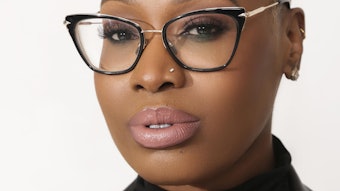At their core, creatives and scientists share a compelling and enduring optimism—a byproduct of their innovative pursuit of a better tomorrow. Pivotal moments of scientific and technological discovery in the past century have not only inspired art, design and marketing, but have fully infiltrated the zeitgeist. The relationship is truly symbiotic: As science inspires art, pop culture has the power to give scientific ideas lift, sustaining the concept’s acceptance and presence with society at large. Our collective concept of beauty is therefore intrinsically tied to major scientific concepts.
The visualization of science in the beauty market is rooted in the shared optimism across disciplines. Science can be seen in beauty advertisements and packaging, underscoring the importance of a designer’s ability to simplify complex technology into a symbolic representation that is aesthetically pleasing, sophisticated and highly positioned for optimal consumer connection. As advances in science and technology continue to accelerate, the onus remains on beauty brand owners and marketers to communicate the impact innovation has on beauty products, marketing and, ultimately, society en masse.
The Unseen Seen
Visualizing science serves to demystify the power of science by creating visual frameworks and symbologies, allowing us to attach meaning and close the loop between logical and emotional desires. These visuals make the unseen seen, the conceptual concrete. Often, these visualizations satisfy just enough understanding to offer us a glimpse into the mystique of science—both giving us a reason to believe in its authenticity and fueling our desire for more.
Yet an important distinction to recognize is that visualizations frequently do not represent actuality. Scientific breakthroughs do not always naturally appeal to consumers, as evidenced by actual DNA strands morphed into a more aesthetically pleasing double helix mode. Instead, visualizations encode meaning deep within their representations, tapping into the power of association the human brain makes between a symbol and its detailed meaning. With scientific and technological discoveries rapidly transforming our daily lives, it will become even more imperative that marketers create ways to communicate complex concepts to beauty consumers.
Science as Art
The relationship between scientific discovery and artistic expression can be traced as far back as 1945, when the world’s first atomic bomb dropped over Hiroshima, forever changing the human psyche and inaugurating the atomic age. With both scientific and civilian circles buzzing with discussion about atomic structure, visual representations of the atom became wildly popular. Striking combinations of straight lines and dots influenced iconic works such as the 1947 Ray Eames classic “dot” pattern and the mobiles of artist Alexander Calder. As the atomic craze gave way to the age of nuclear optimism in the 1950s and the advances in genetic coding in the 1960s, the double helix was adopted as the universal symbol of DNA. By the early ’90s, continued discoveries in the genetic code kept the double helix on the forefront of art and design, and boosted its commercial arrival in brand marketing campaigns and in packaging for foundations, moisturizers and even perfume. And in 1965, with the international space race in full swing, the pixel was used to explain images from probes sent to the moon and Mars. With its roots in digital photography, pixels have since expanded their applications from space exploration to beauty formulas, adorning packages and advertisements with promises of UV protection and precision in makeup and facial creams.
Visualizing Science
While the visual representations of scientific concepts are evident throughout popular art and culture, the process has a practical application as well: It is essential to building the narrative needed to commercialize these innovations. Consumers of beauty products are emotionally invested in a desire for physical transformation, but still require a logical framework in which to place new products claiming wrinkle reduction or teeth whitening.
In other words, while we may believe it is the product we seek—and subsequently purchase—it is science that truly delivers the actual transformation and satiates the underlying emotional desire. Thus, it is crucial that a product’s target consumer has a basic understanding of the science behind the product’s purported beauty benefit. Enter visualization, or a smart and succinct symbol of a scientific concept that allows the consumer to understand how science makes a product work.
Lancôme has mastered effective scientific visualization. Since its creation in 1935, the role of Lancôme’s rose emblem has evolved beyond a logo, taking on a central role in the brand’s communications. In recent decades, Lancôme’s designers have taken inspirational cues from science, particularly the wire frame design used in digital technology, computing and mathematics. Additionally, the rose has been photographed in motion to communicate oscillation. Using the same visual representations scientists rely upon to explain lofty concepts, the rose evolved as the primary visual platform for illustrating the science at play within Lancôme’s various formulas.
The Next Essential Ingredient
Over the course of history, discoveries fueled by industry, medicine, space and war have filtered down into innovation in beauty. For example, a byproduct of the Industrial Revolution introduced chemicals that could perm or color hair. The Information Age’s discovery of plant cell composition led to the integration of natural ingredients into beauty products, and with the ability to clone cells, chemicals and plants have been replaced with people as the essential ingredient of better beauty.
Specifically, recent discoveries have emerged from medical research with enormous potential applications for anti-aging and beauty products and procedures. In 2009, Elizabeth Blackburn, Carol Greider and Jack Szostak were awarded the Nobel Peace Prize in Physiology for the discovery of telomeres—regions at the end of a chromosome that protect its structural integrity but shorten each time a chromosome replicates. Scientists have isolated the enzyme that controls the process of replacing lost DNA, sparking further research into the ability to harness and manipulate this enzyme to influence cancer therapy and the aging process. As a result, telomeres present a potential marketing boon for anti-aging pills and treatments that claim they can now stave off, and even reverse, the lines and wrinkles that come with aging.
The catch: The concept of telomeres is fairly complex, and telomeres themselves are rather unattractive. The solution: the visualization of science. In literature touting the promise telomeres have in beauty products, the DNA double helix is the symbol that communicates that an anti-aging treatment addresses the root cause—the genetic level—of the manifestations of aging. Thus, consumers with only a very basic level of understanding about genetics are able to neatly associate the idea of anti-aging with the double helix, as well as more intuitively understand how the DNA double helix directly relates to anti-aging beauty products.
Necessary Collaboration
No matter how sweetly The Temptations croon, beauty is anything but skin deep. Advances in science and technology are beginning to shift away from the notion that innovation occurs outside the body, that true science and discovery only occurs in labs, and, consequently, that the most valuable beauty solutions come off of a manufacturing line. Indeed, the next great innovation platform will likely be the human body itself.
In the future, there will be a concentrated focus on harnessing the body’s natural and intrinsic agents, like manipulating DNA sequences or removing specific genes altogether. We will begin to define beauty as the manifestation of overall wellness and seek to prevent and treat our imperfections at the subcellular level, instead of topically or surgically.
Science and beauty are irreversibly and inextricably linked to the point that consumers not only desire the science behind the product, they demand it. Effective communication with beauty consumers will hinge on the ability to optimize and visualize the science of nutrition, hydration and sleep, and their effects on outward beauty. Advances in these areas will undoubtedly overtake headlines, seep into the zeitgeist and eventually slip onto beauty packaging—bringing the relationship between science and beauty to its fullest realization.
Liz Grubow is vice president and group creative director of LPK Beauty. In her 20-plus-year career, Grubow has helped develop and manage brand identity programs for some of the world’s most successful beauty brands—including Pantene, Olay, MAX Factor International and Cover Girl.
Elle Morris is the vice president and general manager of LPK Beauty, overseeing its general business management and serving as chief customer officer. She provides strategic oversight on businesses in the categories of hair care, feminine care and beauty. Morris has worked with partners in North America, Latin America, Asia and Europe to develop an understanding of beauty’s power across cultures.










